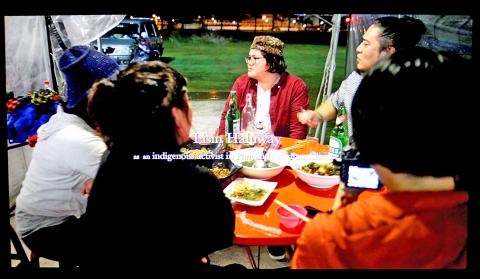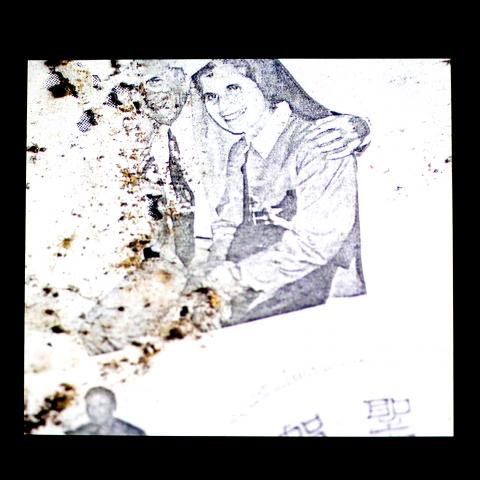Why did you come to Taiwan? (台灣!我來了), a new group show at the Museum of Contemporary Art, Taipei (MOCA, Taipei), is a modern-day examination of identity and migration through the legacy of Spanish colonizers who settled on the northern tip of Taiwan, which they called Formosa, for a brief period in the 17th century.
Though compact compared to the museum’s current main exhibition, Once Upon a Time: Unfinished Progressive Past (少年當代 — 未終結的過去進行式), which looks at youth culture from the 1950s to the 1980s, Why did you come to Taiwan? works as a companion piece with a few promising takes on the country’s colonial past and, more importantly, how it continues into the present.
The title comes from an exclamation made by Salvador Diaz, a historical figure captured by the Dutch to serve as translator during their conquest of Formosa. Taking his cue from Diaz, curator Cheng Shao-hung (程少鴻) invites three artists from Spain and the Philippines and two local artists to respond to colonialism.

Photo: Davina Tham, Taipei Times
Barbara Sanchez Barroso’s documentary short film, Far from Formosa, sees the Spanish artist on a tour of Taipei’s “Little Manila,” a stretch of Zhongshan North Road (中山北路) frequented by the Filipino community that is bound by Saint Christopher’s Church to the north and a one-stop department store to the south.
This is a living, breathing ethnic enclave, and Barroso’s guides, whom she also interviews, are two Filipinos who have transcended the economic pressures that initially brought them to Taiwan: Sherry Macmod Wang, a former domestic helper turned labor rights activist, and Mario Subeldia, the first migrant laborer to receive an artist’s license here.
As descendants of the former colonizer and the colonized, the trio’s encounter produces some moments of insight and constructive discomfort. Walking through the toiletries aisle of a Filipino supermarket, Wang takes the opportunity to explain to a surprised Barroso her country’s obsession with whitening products and light skin as a mark of beauty.

Photo: Davina Tham, Taipei Times
But the work never really delves into the tension inherent in the trio’s relationship and the significance of their meeting in Taiwan, beyond brief mentions of the ignorance of most Spaniards today about Spanish Formosa and questions about the labor rights of migrant workers here. Barroso offers outward curiosity, but little inward inquiry.
For introspection and vulnerability, head to Lee Tzu-tung’s (李紫彤) art video, Writing the Time Lag (時差書寫), which the artist has been filming since 2014. Lee looks at transformations in gender and national identity through Taiwan’s Aboriginal and independence movements.
Backed by an all-female crew, Lee’s interviews become a safe space in which her respondents explore their roles as victims and aggressors. One Aboriginal activist recounts a sexual assault by an older male relative who, after the act was complete, told her, “See, you’re a natural.” Another activist for the Formosan Association for Public Affairs — a Han Chinese woman like Tzu — feels her complicity in past injustices and envies the relationship that Aboriginal communities have to the land and country of Taiwan, which is “without sin.”

Photo: Davina Tham, Taipei Times
Clocking in at a headspinning 70 minutes, with uneven sound levels and intermittent subtitles, Writing the Time Lag can be a difficult work to take in. But Lee does arguably the most honest and soul-searching work of the exhibition, and is an intriguing discovery.
Kao Chun-hung (高俊宏), a more established artist, has two art videos from Sister Ding — But We Never Preach in Spain (丁修女 — 但是我們從來不會去西班牙傳教), which originally showed at last year’s Keelung Harbor Biennale. The work melds ethnographic, historical and paranormal inquiry of two interweaving strands: the ruins of a Spanish abbey on Keelung’s Peace Island (和平島) and its history as told by present-day residents; and the life of Sister Elvira Valentin Martin, a Spanish missionary who served patients with Hansen’s disease, or leprosy, at Losheng (Happy Life) Sanatorium for more than 60 years.
Filipino artist Henrielle Baltazar Pagkaliwangan sheds light on the history of another Asian colony in Beyond the Boxer Codex, an illustrated inventory of artifacts still in use in the Philippines, which the Spaniards introduced during its more than 300 years of settlement. There is no mention of Taiwan in this work, but the objects drawn — from farming tools and furniture, to swords and gilded Catholic figurines — show how colonial violence took on a range of guises and evokes ambivalence toward the colonial legacy, and in fact prompts thinking about local nostalgia for the Japanese colonial era.

Photo: Davina Tham, Taipei Times
Spanish-Welsh artist Rafael Perez Evan rounds out the exhibition with The Devil’s Bird, Ornithomancy, which deploys virtual reality (VR) technology to recreate the lost Truku art of divination from the behaviors of birds in the wild. The VR experience, which suspends the viewer in a rainforest with only a bird for company, respects the beauty and majesty of that setting.
As a coda to the exhibition, the work strikes a crucial ending note, eerily straddling a past in which the future of Taiwan’s people — as settlers, colonial subjects and diplomatic pariahs — had yet to unfold, and a present in which technology and knowledge are more widely available than ever before, but are still not enough to reconcile the violence inflicted on personal and national identities.
EXHIBITION NOTES
What: Why did you come to Taiwan?
When: Until Sep. 29. Open Tuesdays to Sundays from 10am to 6pm
Where: Museum of Contemporary Art Taipei (台北當代藝術館), 39, Changan W Rd, Taipei City (台北市長安西路39號)
Admission: NT$50
On the Net: mocataipei.org.tw

April 14 to April 20 In March 1947, Sising Katadrepan urged the government to drop the “high mountain people” (高山族) designation for Indigenous Taiwanese and refer to them as “Taiwan people” (台灣族). He considered the term derogatory, arguing that it made them sound like animals. The Taiwan Provincial Government agreed to stop using the term, stating that Indigenous Taiwanese suffered all sorts of discrimination and oppression under the Japanese and were forced to live in the mountains as outsiders to society. Now, under the new regime, they would be seen as equals, thus they should be henceforth

Last week, the the National Immigration Agency (NIA) told the legislature that more than 10,000 naturalized Taiwanese citizens from the People’s Republic of China (PRC) risked having their citizenship revoked if they failed to provide proof that they had renounced their Chinese household registration within the next three months. Renunciation is required under the Act Governing Relations Between the People of the Taiwan Area and the Mainland Area (臺灣地區與大陸地區人民關係條例), as amended in 2004, though it was only a legal requirement after 2000. Prior to that, it had been only an administrative requirement since the Nationality Act (國籍法) was established in

With over 80 works on display, this is Louise Bourgeois’ first solo show in Taiwan. Visitors are invited to traverse her world of love and hate, vengeance and acceptance, trauma and reconciliation. Dominating the entrance, the nine-foot-tall Crouching Spider (2003) greets visitors. The creature looms behind the glass facade, symbolic protector and gatekeeper to the intimate journey ahead. Bourgeois, best known for her giant spider sculptures, is one of the most influential artist of the twentieth century. Blending vulnerability and defiance through themes of sexuality, trauma and identity, her work reshaped the landscape of contemporary art with fearless honesty. “People are influenced by

The remains of this Japanese-era trail designed to protect the camphor industry make for a scenic day-hike, a fascinating overnight hike or a challenging multi-day adventure Maolin District (茂林) in Kaohsiung is well known for beautiful roadside scenery, waterfalls, the annual butterfly migration and indigenous culture. A lesser known but worthwhile destination here lies along the very top of the valley: the Liugui Security Path (六龜警備道). This relic of the Japanese era once isolated the Maolin valley from the outside world but now serves to draw tourists in. The path originally ran for about 50km, but not all of this trail is still easily walkable. The nicest section for a simple day hike is the heavily trafficked southern section above Maolin and Wanshan (萬山) villages. Remains of